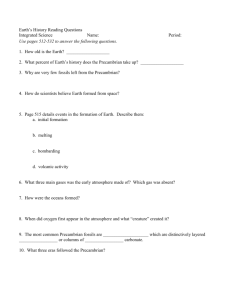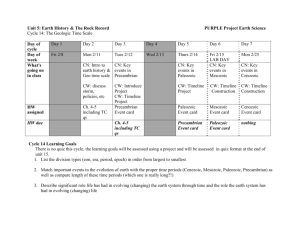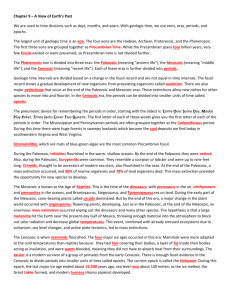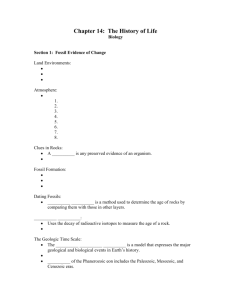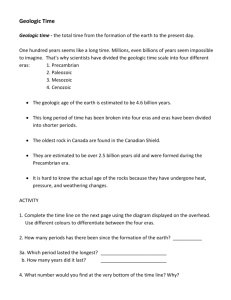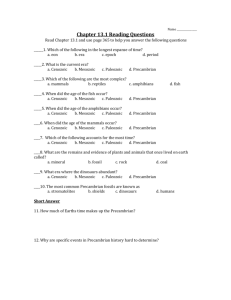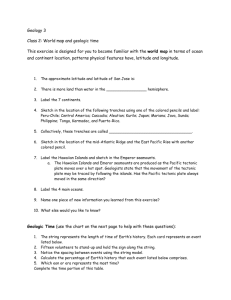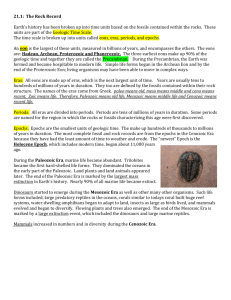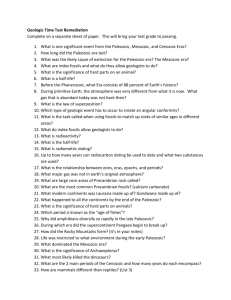A. Precambrian B. Paleozoic c. Mesozoic d. Cenozoic
advertisement
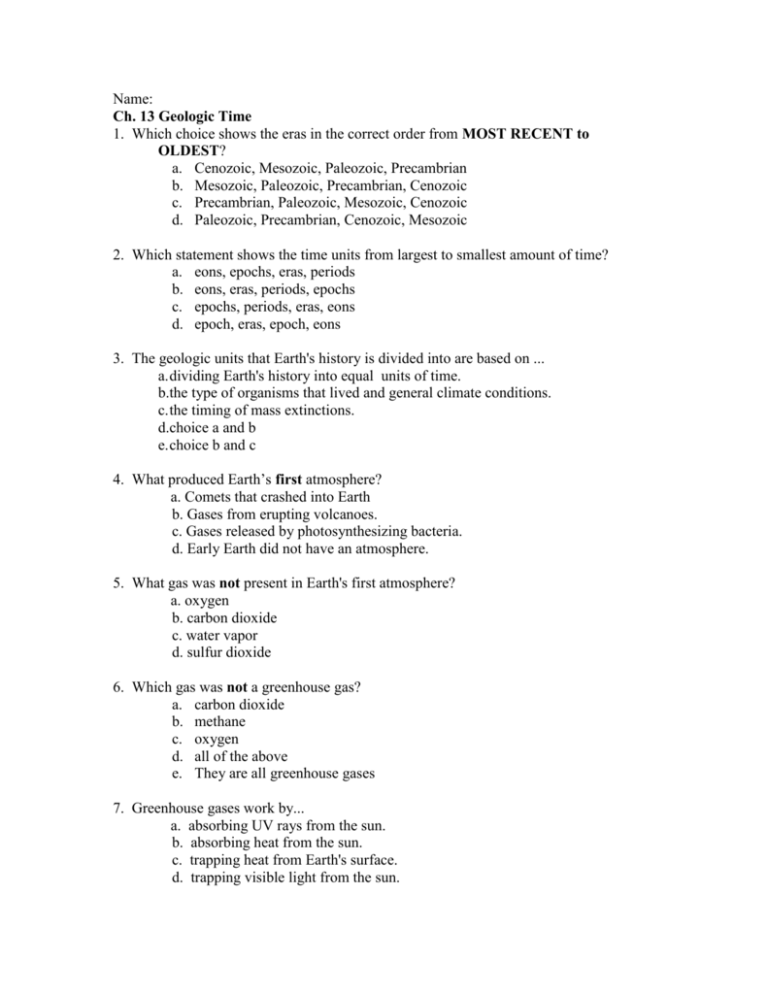
Name: Ch. 13 Geologic Time 1. Which choice shows the eras in the correct order from MOST RECENT to OLDEST? a. Cenozoic, Mesozoic, Paleozoic, Precambrian b. Mesozoic, Paleozoic, Precambrian, Cenozoic c. Precambrian, Paleozoic, Mesozoic, Cenozoic d. Paleozoic, Precambrian, Cenozoic, Mesozoic 2. Which statement shows the time units from largest to smallest amount of time? a. eons, epochs, eras, periods b. eons, eras, periods, epochs c. epochs, periods, eras, eons d. epoch, eras, epoch, eons 3. The geologic units that Earth's history is divided into are based on ... a. dividing Earth's history into equal units of time. b.the type of organisms that lived and general climate conditions. c. the timing of mass extinctions. d.choice a and b e. choice b and c 4. What produced Earth’s first atmosphere? a. Comets that crashed into Earth b. Gases from erupting volcanoes. c. Gases released by photosynthesizing bacteria. d. Early Earth did not have an atmosphere. 5. What gas was not present in Earth's first atmosphere? a. oxygen b. carbon dioxide c. water vapor d. sulfur dioxide 6. Which gas was not a greenhouse gas? a. carbon dioxide b. methane c. oxygen d. all of the above e. They are all greenhouse gases 7. Greenhouse gases work by... a. absorbing UV rays from the sun. b. absorbing heat from the sun. c. trapping heat from Earth's surface. d. trapping visible light from the sun. 8. a. b. c. d. According to the fossil record, the first life on planet Earth was … Single celled bacteria that survived in toxic environments. Photosynthesizing bacteria that released oxygen. Dinosaurs Corals 9. Which choices represent contributions cyanobacteria made to the Earth's environment? (Circle all that apply). a. Releasing carbon dioxide b. Releasing oxygen c. Providing the material needed for an ozone layer d. Global warming e. Global cooling 10. Ozone is important to life on Earth because ... a. It is the main greenhouse gas that keeps the planet from freezing. b. It breaks down greenhouse gases and combats global warming. c. It absorbs UV rays from the sun. d. It essential to forming the oxygen organisms breathe. 11. During times when volcanoes were very active, carbon dioxide levels ___________________. a. Decreased b. Increased c. Stayed the same 12. Ozone provided the greatest benefit to ... a. photosynthesizing bacteria and plants. b. marine organisms c. terrestrial organisms d. dinosaurs 13. Supercontinent break ups are usually .. a. followed by cooling periods. b. accompanied by global increase in volcanic activity c. a series of ice ages. d. decreased carbon dioxide levels. 14. Which choice is partially responsible for initiating the global ice age known as “Snowball Earth”? a. Asteroid impacts c. photosynthesizing bacteria b. Methane release d. flood basalts 15. Which choice is partially responsible for ending the global ice age known as “Snowball Earth”? a. Asteroid impacts c. volcanic activity b. Methane release d. mountain building 16. Flood basalts mainly cause mass extinctions by … a. blocking sunlight and causing cooling. b. Releasing methane and causing warming. c. Releasing carbon dioxide and causing warming. d. Lava destroys habitats. 17. Which statements are TRUE about methane? CIRCLE ALL THAT APPLY. a. It is removed from the atmosphere by photosynthesizing bacteria. b. It can exist as a solid crystal on the sea floor. c. It is a potent greenhouse gas. d. It absorbs UV rays from the sun. e. It is the main volcanic gas. 18. What conditions can cause a methane release from the sea? a. decrease in temperature of sea water. b. Increase in the salinity (saltiness) of sea water. c. Increase in the temperature of sea water. d. Increase in the amount of overlying sediments burying the methane. e. Earthquakes that remove overlying sediments from buried methane. 19. Why was the Mesozoic so steamy? a. Increased and prolonged volcanic activity. b. A supercontinent was forming. c. Increased and prolonged mountain building. d. The extinction of cyanobacteria. e. An increase in ozone 20. The presence of iridium in rock layers indicates that there was a(n) … a. flood basalt c. impact from a meteor b. methane release d. glaciation Name that ERA! A. Precambrian 21. 22. 23. 24. 25. 26. 27. 28. B. Paleozoic c. Mesozoic d. Cenozoic Life invades the land; land plants, insects, amphibians, and reptiles appear and flourish. “Age of Dinosaurs” “Age of Mammals” Starts with the Cambrian explosion Ends with Snowball Earth Pangaea assembles Pangaea breaks apart First mammals evolve Name that ERA! A. Precambrian B. Paleozoic c. Mesozoic d. Cenozoic 29. Series of ice ages, mountain building (Alps, Himalayas, Rockies) 30. First life evolves A = TRUE; B= FALSE If false, correct the statement to make it true. 31. Each era ends with a mass extinction. 32. The “Age of Mammals” began 245 million years ago. 33. The first atmosphere had oxygen. 34. Life forms lived on land during Precambrian time. 35. Precambrian was the longest unit of time. Open Ended: Earth is a system of connected spheres that interact. Give an example of how a change in geology has caused a change in biology (life forms). Provide details in your example.
